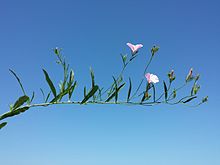Cantabrian winds
| Cantabrian winds | ||||||||||||
|---|---|---|---|---|---|---|---|---|---|---|---|---|

Cantabrian Winds ( Convolvulus cantabrica ) |
||||||||||||
| Systematics | ||||||||||||
|
||||||||||||
| Scientific name | ||||||||||||
| Convolvulus cantabrica | ||||||||||||
| L. |
The convolvulus cantabrica ( Convolvulus cantabrica ) is a plant of the genus winches ( Convolvulus ) within the family of wind plants (Convolvulaceae).
description
Vegetative characteristics
The Cantabrian Winds is a perennial herbaceous plant that reaches heights of 10 to 50 centimeters.
The basal leaves are divided into long petioles and leaf blades. Your leaf blades are spatulate or obovate-oblong, blunt and entire. From the bottom up, the leaves gradually merge into the upper, sessile, linear-lanceolate, pointed leaves. All leaves are gray-green and shaggy hairy.
Generative characteristics
The flowers stand individually or in twos, terminal or axillary or up to five in shawn-gold inflorescences . The inflorescence is 10 to 50 centimeters high and is clearly branched. The lateral inflorescences are 4.5 to 10, rarely up to 15 centimeters long and stalked long.
The hermaphrodite flowers are radially symmetrical with a double flower envelope . The shaggy, hairy calyx tips are elongated to linear-lanceolate with a pointed upper end. The pink crown is funnel-shaped with a length of about 2 centimeters and a diameter of 3 to 4 centimeters and is silky hairy on the folds. The stylus is shaggy hairy.
The capsule fruit is pointed rounded-oval with a length 6-8 millimeters, and by the permanent pen at the upper end. The seeds are egg-shaped with a length of 3 to 4 millimeters.
The flowering period extends from July to August.
The number of chromosomes is 2n = 30.
Occurrence
The Cantabrian winds are common in southern Europe , southern central Europe , Anatolia , the Caucasus, and Iran and Afghanistan. It occurs on roadsides and on rocky slopes at altitudes of up to 1700 meters. It thrives mainly in lime-loving therophyte societies of the Thero-Brachypodion association.
Systematics
The Cantabrian Winds was first published in 1753 by Carl von Linné in Species Plantarum . The specific epithet cantabrica was introduced by Linné as a noun because Charles de l'Écluse, quoted in the protologue , had called the plant Cantabrica quorundam . It cannot therefore be changed to “ cantabricus ”.
use
The Cantabrian winch is rarely used as an ornamental plant for rock gardens.
supporting documents
literature
- Eckehart J. Jäger, Friedrich Ebel, Peter Hanelt, Gerd K. Müller (eds.): Excursion flora from Germany . Founded by Werner Rothmaler. tape 5 : Herbaceous ornamental and useful plants . Springer, Spektrum Akademischer Verlag, Berlin / Heidelberg 2008, ISBN 978-3-8274-0918-8 .
Individual evidence
- ↑ a b c d Gustav Hegi: Illustrated flora of Central Europe. Pteridophyta, Spermatophyta. 2nd Edition. Volume V. Part 1: Angiospermae: Dicotyledones 3 (1) (Linaceae - Violaceae) . Carl Hanser and Paul Parey, Munich and Berlin / Hamburg 1966, ISBN 3-489-72021-0 , p. 2085–2086 (unchanged reprint from 1925 with addendum).
- ↑ CA Stace: Convolvulus L. In: Thomas Gaskell Tutin u. a .: Flora Europaea . Volume 3, pages 79-82. Cambridge University Press 1972. ISBN 0-521-08489-X
- ^ Rafaël Govaerts (Ed.): Convolvulus cantabrica. In: World Checklist of Selected Plant Families (WCSP) - The Board of Trustees of the Royal Botanic Gardens, Kew . Retrieved November 20, 2017.
- ↑ David Aeschimann, Konrad Lauber, Daniel Martin Moser, Jean-Paul Theurillat: Flora alpina. Volume 2, page 54. Bern, Stuttgart, Vienna Haupt-Verlag, 2004. ISBN 3-258-06600-0
- ↑ Carl von Linné: Species Plantarum. Volume 1, Impensis Laurentii Salvii, Holmiae 1753, p. 158, digitized
- ↑ International Code for Botanical Nomenclature (ICBN) Art. 23.5 and Ex. 6



